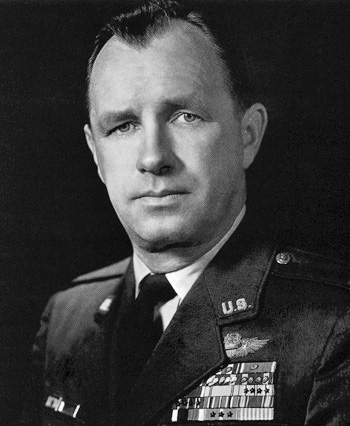
|
Harrison R. Thyng |
 |
|||
| Rank, Service | ||||
Brigadier General O-7, U.S. Air Force |
||||
| Veteran of: | ||||
|
||||
| Tribute: | ||||
Harry Thyng was born on April 12, 1918, in Laconia, New Hampshire. He was commissioned a 2d Lt of Infantry in the U.S. Army Reserve through the Army ROTC program at the University of New Hampshire on May 27, 1939, and entered the Aviation Cadet Program of the U.S. Army Air Corps on June 27, 1939. Lt Thyng was awarded his pilot wings at Kelly Field, Texas, on March 24, 1940, and then served with the 94th Pursuit Squadron of the 1st Pursuit Group at Selfridge Field, Michigan, from March to October 1940. Lt Thyng next served with the 41st Pursuit Squadron of the 31st Pursuit Group, first at Selfridge Field and later at Baer Field, Indiana, from October 1940 to January 1942. He then became the first commander of the 309th Fighter Squadron under the 31st Fighter Group, moving with the group to New Orleans, Louisiana, in February 1942, and then deployed to England in June 1942, flying British Spitfires. Maj Thyng led the first American fighter raids out of England during this time, and commanded the 309th through the North Africa Invasion in November 1942 until returning to the U.S. in May 1943. He was credited with the destruction of 5 enemy aircraft in aerial combat plus 2 probables and 3 damaged between August 1942 and May 1943. After recovering from injuries he received in North Africa, Col Thyng completed P-47 Thunderbolt training and then took command of the 413th Fighter Group at Bluethenthal Field, North Carolina, in November 1944. He moved with the group to Ie Shima in June 1945, and was credited with another probable air victory before returning to the U.S. in October 1945. During this time he flew on the long-range escort mission of the B-29 Bockscar on the second atomic bombing mission against Nagasaki, Japan, on August 9, 1945. After the war, Col Thyng transitioned into the P-80 Shooting Star jet fighter and served as a jet fighter instructor for the Air National Guard from September 1947 to November 1951. He was commander of the 4th Fighter Interceptor Wing in Korea from November 1951 to October 1952, during which time he was credited with the destruction of 5 enemy aircraft in aerial combat plus 4 damaged, for a two-war total of 10 destroyed in the air, 3 probables, and 7 damaged. He shot down most of his "damaged" aircraft, but had a practice of giving victories to his wingmen who protected him in combat. After Korea, Col Thyng served as Deputy for Operations with Headquarters Western Air Defense Force at Hamilton AFB, California, from December 1952 to June 1954, and then commander of the 4702nd Defense Wing at Geiger Field, Washington, from June to October 1954. His next assignment was as commander and vice commander of the 9th Air Division at Geiger Field from October 1954 to July 1957. Col Thyng attended National War College from July 1957 to July 1958, and then served with Headquarters U.S. Air Force in the Pentagon until January 1959. He next served with the Federal Aviation Administration in Washington, D.C., from January 1959 to October 1960, followed by service as commander of the Duluth Air Defense Sector at Duluth Municipal Airport, Minnesota, from October 1960 to July 1963. Gen Thyng was vice commander of the Northern NORAD Region at RCAF North Bay in Ontario, Canada, from July 1963 to January 1966, followed by service as commander of the Washington Air Defense Sector at Fort Lee AFS, Virginia, from January 1966 until his retirement from the Air Force on April 1, 1966. After retiring from the Air Force, Harry ran for the U.S. Senate in New Hampshire, but lost to the incumbent candidate. He also founded the New England Aeronautical Institute which later merged with Daniel Webster Junior College and became Daniel Webster College in Nashua, New Hampshire. Harry Thyng died on September 24, 1983. He was one of only 7 Americans to become an ace in two wars. |
||||
|
||||

